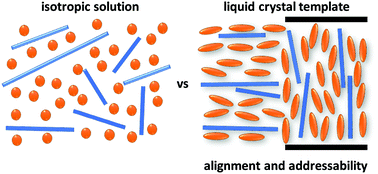当前位置:
X-MOL 学术
›
Chem. Soc. Rev.
›
论文详情
Our official English website, www.x-mol.net, welcomes your
feedback! (Note: you will need to create a separate account there.)
Liquid crystal templating as an approach to spatially and temporally organise soft matter
Chemical Society Reviews ( IF 40.4 ) Pub Date : 2017-07-24 00:00:00 , DOI: 10.1039/c7cs00029d Pim van der Asdonk 1, 2, 3, 4 , Paul H. J. Kouwer 1, 2, 3, 4
Chemical Society Reviews ( IF 40.4 ) Pub Date : 2017-07-24 00:00:00 , DOI: 10.1039/c7cs00029d Pim van der Asdonk 1, 2, 3, 4 , Paul H. J. Kouwer 1, 2, 3, 4
Affiliation

|
Chemistry quickly moves from a molecular science to a systems science. This requires spatial and temporal control over the organisation of molecules and molecular assemblies. Whilst Nature almost by default (transiently) organises her components at multiple different length scales, scientists struggle to realise even relatively straightforward patterns. In the past decades, supramolecular chemistry has taught us the rules to precisely engineer molecular assembly at the nanometre scale. At higher length scales, however, we are bound to top-down nanotechnology techniques to realise order. For soft, biological matter, many of these top-down techniques come with serious limitations since the molecules generally show low susceptibilities to the applied stimuli. A new method is based on liquid crystal templating. In this hierarchical approach, a liquid crystalline host serves as the scaffold to order polymers or assemblies. Being a liquid crystal, the host material can be ordered at many different length scales and on top of that, is highly susceptible to many external stimuli, which can even be used to manipulate the liquid crystal organisation in time. As a result, we anticipate large control over the organisation of the materials inside the liquid crystalline host. Recently, liquid crystal templating was also realised in water. This suddenly makes this tool highly applicable to start organising more delicate biological materials or even small organisms. We review the scope and limitations of liquid crystal templating and look out to where the technique may lead us.
中文翻译:

液晶模板作为在空间和时间上组织软物质的一种方法
化学迅速从分子科学转变为系统科学。这需要对分子和分子组装体的组织进行空间和时间控制。虽然自然几乎默认情况下(短暂地)以多种不同的长度尺度来组织她的组件,但科学家们仍在努力实现甚至相对简单的模式。在过去的几十年中,超分子化学教会了我们在纳米尺度上精确设计分子组装的规则。但是,在更高的长度尺度上,我们必须采用自上而下的纳米技术来实现有序化。对于柔软的生物物质,许多自上而下的技术都存在严重的局限性,因为分子通常对所施加的刺激表现出较低的敏感性。一种新方法基于液晶模板。在这种分层方法中,液晶主体用作支架以订购聚合物或组件。作为一种液晶,主体材料可以按许多不同的长度比例进行排序,并且最重要的是,它容易受到许多外部刺激的影响,甚至可以及时用于操纵液晶组织。结果,我们期望对液晶主体内部材料的组织进行大规模控制。最近,在水中也实现了液晶模板化。这突然使该工具非常适用于开始组织更精细的生物材料甚至小型生物。我们回顾了液晶模板的范围和局限性,并探讨了该技术可能将我们引向何处。可以以多种不同的长度尺度订购主体材料,最重要的是,主体材料极易受到许多外部刺激的影响,甚至可以用来及时操纵液晶组织。结果,我们期望对液晶主体内部材料的组织进行大规模控制。最近,在水中也实现了液晶模板化。这突然使该工具非常适用于开始组织更精细的生物材料甚至小型生物。我们回顾了液晶模板的范围和局限性,并探讨了该技术可能将我们引向何处。可以以多种不同的长度尺度订购主体材料,最重要的是,主体材料极易受到许多外部刺激的影响,甚至可以用来及时操纵液晶组织。结果,我们期望对液晶主体内部材料的组织进行大规模控制。最近,在水中也实现了液晶模板化。这突然使该工具非常适用于开始组织更精细的生物材料甚至小型生物。我们回顾了液晶模板的范围和局限性,并探讨了该技术可能将我们引向何处。我们预计将对液晶主体内部材料的组织进行大规模控制。最近,在水中也实现了液晶模板化。这突然使该工具非常适用于开始组织更精细的生物材料甚至小型生物。我们回顾了液晶模板的范围和局限性,并探讨了该技术可能将我们引向何处。我们预计将对液晶主体内部材料的组织进行大规模控制。最近,在水中也实现了液晶模板化。这突然使该工具非常适用于开始组织更精细的生物材料甚至小型生物。我们回顾了液晶模板的范围和局限性,并探讨了该技术可能将我们引向何处。
更新日期:2017-07-25
中文翻译:

液晶模板作为在空间和时间上组织软物质的一种方法
化学迅速从分子科学转变为系统科学。这需要对分子和分子组装体的组织进行空间和时间控制。虽然自然几乎默认情况下(短暂地)以多种不同的长度尺度来组织她的组件,但科学家们仍在努力实现甚至相对简单的模式。在过去的几十年中,超分子化学教会了我们在纳米尺度上精确设计分子组装的规则。但是,在更高的长度尺度上,我们必须采用自上而下的纳米技术来实现有序化。对于柔软的生物物质,许多自上而下的技术都存在严重的局限性,因为分子通常对所施加的刺激表现出较低的敏感性。一种新方法基于液晶模板。在这种分层方法中,液晶主体用作支架以订购聚合物或组件。作为一种液晶,主体材料可以按许多不同的长度比例进行排序,并且最重要的是,它容易受到许多外部刺激的影响,甚至可以及时用于操纵液晶组织。结果,我们期望对液晶主体内部材料的组织进行大规模控制。最近,在水中也实现了液晶模板化。这突然使该工具非常适用于开始组织更精细的生物材料甚至小型生物。我们回顾了液晶模板的范围和局限性,并探讨了该技术可能将我们引向何处。可以以多种不同的长度尺度订购主体材料,最重要的是,主体材料极易受到许多外部刺激的影响,甚至可以用来及时操纵液晶组织。结果,我们期望对液晶主体内部材料的组织进行大规模控制。最近,在水中也实现了液晶模板化。这突然使该工具非常适用于开始组织更精细的生物材料甚至小型生物。我们回顾了液晶模板的范围和局限性,并探讨了该技术可能将我们引向何处。可以以多种不同的长度尺度订购主体材料,最重要的是,主体材料极易受到许多外部刺激的影响,甚至可以用来及时操纵液晶组织。结果,我们期望对液晶主体内部材料的组织进行大规模控制。最近,在水中也实现了液晶模板化。这突然使该工具非常适用于开始组织更精细的生物材料甚至小型生物。我们回顾了液晶模板的范围和局限性,并探讨了该技术可能将我们引向何处。我们预计将对液晶主体内部材料的组织进行大规模控制。最近,在水中也实现了液晶模板化。这突然使该工具非常适用于开始组织更精细的生物材料甚至小型生物。我们回顾了液晶模板的范围和局限性,并探讨了该技术可能将我们引向何处。我们预计将对液晶主体内部材料的组织进行大规模控制。最近,在水中也实现了液晶模板化。这突然使该工具非常适用于开始组织更精细的生物材料甚至小型生物。我们回顾了液晶模板的范围和局限性,并探讨了该技术可能将我们引向何处。









































 京公网安备 11010802027423号
京公网安备 11010802027423号